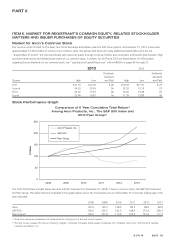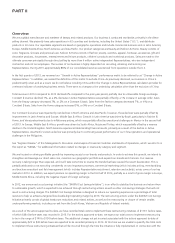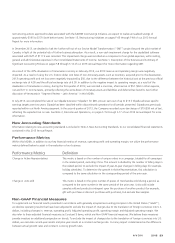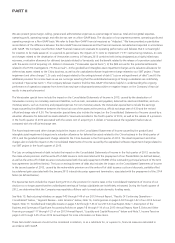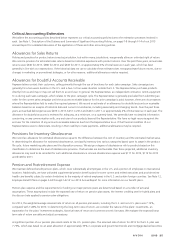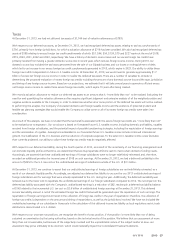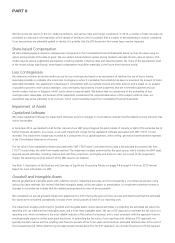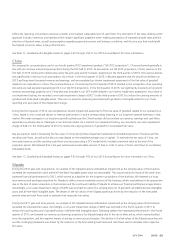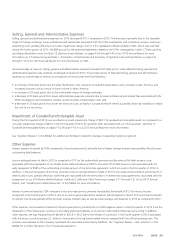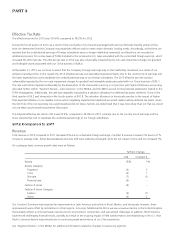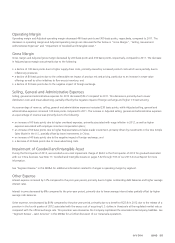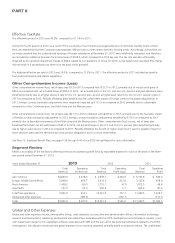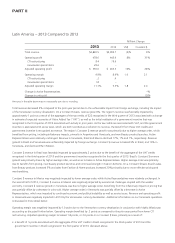Avon 2013 Annual Report Download - page 36
Download and view the complete annual report
Please find page 36 of the 2013 Avon annual report below. You can navigate through the pages in the report by either clicking on the pages listed below, or by using the keyword search tool below to find specific information within the annual report.PART II
We file income tax returns in the U.S. federal jurisdiction, and various state and foreign jurisdictions. In 2014, a number of open tax years are
scheduled to close due to the expiration of the statute of limitations and it is possible that a number of tax examinations may be completed.
If our tax positions are ultimately upheld or denied, it is possible that the 2014 provision for income taxes may be impacted.
Share-based Compensation
All share-based payments issued to employees are recognized in the Consolidated Financial Statements based on their fair value using an
option-pricing model at the date of grant. We use a Black-Scholes-Merton option-pricing model to calculate the fair value of options. This
model requires various judgmental assumptions including volatility, forfeiture rates and expected option life. If any of the assumptions used
in the model change significantly, share-based compensation may differ materially in the future from historical results.
Loss Contingencies
We determine whether to disclose and/or accrue for loss contingencies based on an assessment of whether the risk of loss is remote,
reasonably possible or probable. We record loss contingencies when it is probable that a liability has been incurred and the amount of loss is
reasonably estimable. Our assessment is developed in consultation with our outside counsel and other advisors and is based on an analysis
of possible outcomes under various strategies. Loss contingency assumptions involve judgments that are inherently subjective and can
involve matters that are in litigation, which, by its nature is unpredictable. We believe that our assessment of the probability of loss
contingencies is reasonable, but because of the subjectivity involved and the unpredictable nature of the subject matter at issue, our
assessment may prove ultimately to be incorrect, which could materially impact the Consolidated Financial Statements.
Impairment of Assets
Capitalized Software
We review capitalized software for impairment whenever events or changes in circumstances indicate that the related carrying amounts may
not be recoverable.
In December 2013, we decided to halt further roll-out of our SMT project beyond the pilot market of Canada, in light of the potential risk of
further business disruption. As a result, a non-cash impairment charge for the capitalized software associated with SMT of $117.2 was
recorded. This impairment charge was recorded as a component of our global expenses, within selling, general and administrative expenses
in the Consolidated Statements of Income.
The fair value of the capitalized software associated with SMT (“SMT asset”) was determined using a risk-adjusted discounted cash flow
(“DCF”) model under the relief-from-royalty method. The impairment analysis performed for the asset group, which includes the SMT asset,
required several estimates, including revenue and cash flow projections, and royalty and discount rates. As a result of this impairment
charge, the remaining carrying amount of the SMT asset is not material.
See Note 1, Description of the Business and Summary of Significant Accounting Policies on pages F-8 through F-14 of our 2013 Annual
Report for more information on SMT.
Goodwill and Intangible Assets
We test goodwill and intangible assets with indefinite lives for impairment annually, and more frequently if circumstances warrant, using
various fair value methods. We review finite-lived intangible assets, which are subject to amortization, for impairment whenever events or
changes in circumstances indicate that the related carrying amounts may not be recoverable.
We completed our annual goodwill impairment assessment for 2013 during the year-end close process and determined that the estimated
fair values were considered substantially in excess of the carrying values of each of our reporting units.
The impairment analyses performed for goodwill and intangible assets require several estimates in computing the estimated fair value of a
reporting unit, an indefinite-lived intangible asset, and a finite-lived intangible asset. We use a DCF approach to estimate the fair value of a
reporting unit, which we believe is the most reliable indicator of fair value of a business, and is most consistent with the approach that we
would generally expect a market participant would use. In estimating the fair value of our reporting units utilizing a DCF approach, we
typically forecast revenue and the resulting cash flows for periods of five to ten years and include an estimated terminal value at the end of
the forecasted period. When determining the appropriate forecast period for the DCF approach, we consider the amount of time required



